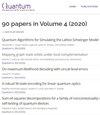Charge and Spin Sharpening Transitions on Dynamical Quantum Trees
IF 5.1
2区 物理与天体物理
Q1 PHYSICS, MULTIDISCIPLINARY
引用次数: 0
Abstract
The dynamics of monitored systems can exhibit a measurement-induced phase transition (MIPT) between entangling and disentangling phases, tuned by the measurement rate. When the dynamics obeys a continuous symmetry, the entangling phase further splits into a fuzzy phase and a sharp phase based on the scaling of fluctuations of the symmetry charge. While the sharpening transition for Abelian symmetries is well understood analytically, no such understanding exists for the non- Abelian case. In this work, building on a recent analytical solution of the MIPT on tree-like circuit architectures (where qubits are repatedly added or removed from the system in a recursive pattern), we study entanglement and sharpening transitions in monitored dynamical quantum trees obeying $U(1)$ and $SU(2)$ symmetries. The recursive structure of tree tensor networks enables powerful analytical and numerical methods to determine the phase diagrams in both cases. In the $U(1)$ case, we analytically derive a Fisher-KPP-like differential equation that allows us to locate the critical point and identify its properties. We find that the entanglement/purification and sharpening transitions generically occur at distinct measurement rates. In the $SU(2)$ case, we find that the fuzzy phase is generic, and a sharp phase is possible only in the limit of maximal measurement rate. In this limit, we analytically solve the boundaries separating the fuzzy and sharp phases, and find them to be in agreement with exact numerical simulations.动态量子树上的电荷和自旋锐化跃迁
被监测系统的动力学可以表现出纠缠相和解纠缠相之间的测量诱导相变(MIPT),由测量速率调节。当动力学服从连续对称时,基于对称电荷涨落的标度,纠缠相进一步分裂为模糊相和尖锐相。虽然阿贝尔对称的锐化转变在分析上得到了很好的理解,但对于非阿贝尔对称情况却没有这样的理解。在这项工作中,基于树状电路架构(其中量子比特以递归模式从系统中重复添加或删除)上最近的MIPT解析解,我们研究了遵循$U(1)$和$SU(2)$对称性的监控动态量子树中的纠缠和锐化转换。树张量网络的递归结构使强大的分析和数值方法能够确定这两种情况下的相图。在$U(1)$的情况下,我们解析地推导出一个类似fisher - kpp的微分方程,使我们能够找到临界点并确定其性质。我们发现纠缠/净化和锐化转变通常以不同的测量速率发生。在$SU(2)$情况下,我们发现模糊相位是一般的,只有在最大测量速率的极限下才可能出现锐相位。在此极限下,我们解析解出了模糊相位和锐相位的边界,并发现它们与精确的数值模拟相吻合。
本文章由计算机程序翻译,如有差异,请以英文原文为准。
求助全文
约1分钟内获得全文
求助全文
来源期刊

Quantum
Physics and Astronomy-Physics and Astronomy (miscellaneous)
CiteScore
9.20
自引率
10.90%
发文量
241
审稿时长
16 weeks
期刊介绍:
Quantum is an open-access peer-reviewed journal for quantum science and related fields. Quantum is non-profit and community-run: an effort by researchers and for researchers to make science more open and publishing more transparent and efficient.
 求助内容:
求助内容: 应助结果提醒方式:
应助结果提醒方式:


